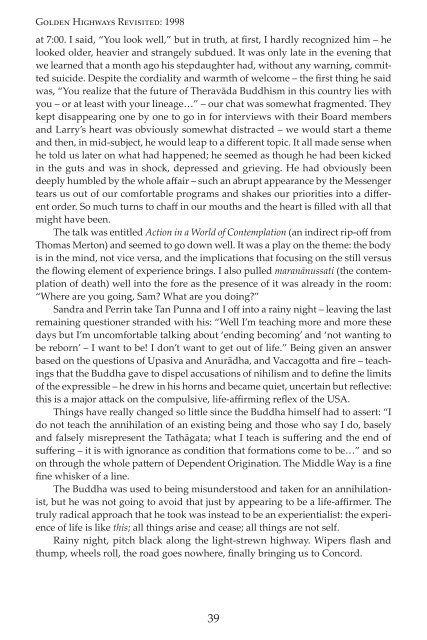Rugged Interdependency - Amaravati Buddhist Monastery
Rugged Interdependency - Amaravati Buddhist Monastery
Rugged Interdependency - Amaravati Buddhist Monastery
- No tags were found...
You also want an ePaper? Increase the reach of your titles
YUMPU automatically turns print PDFs into web optimized ePapers that Google loves.
Golden Highways Revisited: 1998at 7:00. I said, “You look well,” but in truth, at first, I hardly recognized him – helooked older, heavier and strangely subdued. It was only late in the evening thatwe learned that a month ago his stepdaughter had, without any warning, committedsuicide. Despite the cordiality and warmth of welcome – the first thing he saidwas, “You realize that the future of Theravāda Buddhism in this country lies withyou – or at least with your lineage…” – our chat was somewhat fragmented. Theykept disappearing one by one to go in for interviews with their Board membersand Larry’s heart was obviously somewhat distracted – we would start a themeand then, in mid-subject, he would leap to a different topic. It all made sense whenhe told us later on what had happened; he seemed as though he had been kickedin the guts and was in shock, depressed and grieving. He had obviously beendeeply humbled by the whole affair – such an abrupt appearance by the Messengertears us out of our comfortable programs and shakes our priorities into a differentorder. So much turns to chaff in our mouths and the heart is filled with all thatmight have been.The talk was entitled Action in a World of Contemplation (an indirect rip-off fromThomas Merton) and seemed to go down well. It was a play on the theme: the bodyis in the mind, not vice versa, and the implications that focusing on the still versusthe flowing element of experience brings. I also pulled maranānussati (the contemplationof death) well into the fore as the presence of it was already in the room:“Where are you going, Sam? What are you doing?”Sandra and Perrin take Tan Punna and I off into a rainy night – leaving the lastremaining questioner stranded with his: “Well I’m teaching more and more thesedays but I’m uncomfortable talking about ‘ending becoming’ and ‘not wanting tobe reborn’ – I want to be! I don’t want to get out of life.” Being given an answerbased on the questions of Upasiva and Anurādha, and Vaccagotta and fire – teachingsthat the Buddha gave to dispel accusations of nihilism and to define the limitsof the expressible – he drew in his horns and became quiet, uncertain but reflective:this is a major attack on the compulsive, life-affirming reflex of the USA.Things have really changed so little since the Buddha himself had to assert: “Ido not teach the annihilation of an existing being and those who say I do, baselyand falsely misrepresent the Tathāgata; what I teach is suffering and the end ofsuffering – it is with ignorance as condition that formations come to be…” and soon through the whole pattern of Dependent Origination. The Middle Way is a finefine whisker of a line.The Buddha was used to being misunderstood and taken for an annihilationist,but he was not going to avoid that just by appearing to be a life-affirmer. Thetruly radical approach that he took was instead to be an experientialist: the experienceof life is like this; all things arise and cease; all things are not self.Rainy night, pitch black along the light-strewn highway. Wipers flash andthump, wheels roll, the road goes nowhere, finally bringing us to Concord.39
















